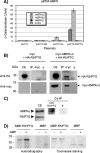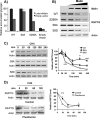AMP-activated protein kinase phosphorylates R5/PTG, the glycogen targeting subunit of the R5/PTG-protein phosphatase 1 holoenzyme, and accelerates its down-regulation by the laforin-malin complex
- PMID: 19171932
- PMCID: PMC2659182
- DOI: 10.1074/jbc.M808492200
AMP-activated protein kinase phosphorylates R5/PTG, the glycogen targeting subunit of the R5/PTG-protein phosphatase 1 holoenzyme, and accelerates its down-regulation by the laforin-malin complex
Abstract
R5/PTG is one of the glycogen targeting subunits of type 1 protein phosphatase, a master regulator of glycogen synthesis. R5/PTG recruits the phosphatase to the places where glycogen synthesis occurs, allowing the activation of glycogen synthase and the inactivation of glycogen phosphorylase, thus increasing glycogen synthesis and decreasing its degradation. In this report, we show that the activity of R5/PTG is regulated by AMP-activated protein kinase (AMPK). We demonstrate that AMPK interacts physically with R5/PTG and modifies its basal phosphorylation status. We have also mapped the major phosphorylation sites of R5/PTG by mass spectrometry analysis, observing that phosphorylation of Ser-8 and Ser-268 increased upon activation of AMPK. We have recently described that the activity of R5/PTG is down-regulated by the laforin-malin complex, composed of a dual specificity phosphatase (laforin) and an E3-ubiquitin ligase (malin). We now demonstrate that phosphorylation of R5/PTG at Ser-8 by AMPK accelerates its laforin/malin-dependent ubiquitination and subsequent proteasomal degradation, which results in a decrease of its glycogenic activity. Thus, our results define a novel role of AMPK in glycogen homeostasis.
Figures







Similar articles
-
Malin decreases glycogen accumulation by promoting the degradation of protein targeting to glycogen (PTG).J Biol Chem. 2008 Feb 15;283(7):4069-76. doi: 10.1074/jbc.M708712200. Epub 2007 Dec 10. J Biol Chem. 2008. PMID: 18070875 Free PMC article.
-
Regulation of glycogen synthesis by the laforin-malin complex is modulated by the AMP-activated protein kinase pathway.Hum Mol Genet. 2008 Mar 1;17(5):667-78. doi: 10.1093/hmg/ddm339. Epub 2007 Nov 20. Hum Mol Genet. 2008. PMID: 18029386
-
The laforin-malin complex, involved in Lafora disease, promotes the incorporation of K63-linked ubiquitin chains into AMP-activated protein kinase beta subunits.Mol Biol Cell. 2010 Aug 1;21(15):2578-88. doi: 10.1091/mbc.e10-03-0227. Epub 2010 Jun 9. Mol Biol Cell. 2010. PMID: 20534808 Free PMC article.
-
The regulation of muscle glycogen: the granule and its proteins.Acta Physiol (Oxf). 2010 Aug;199(4):489-98. doi: 10.1111/j.1748-1716.2010.02131.x. Epub 2010 Mar 26. Acta Physiol (Oxf). 2010. PMID: 20353490 Review.
-
Lafora disease offers a unique window into neuronal glycogen metabolism.J Biol Chem. 2018 May 11;293(19):7117-7125. doi: 10.1074/jbc.R117.803064. Epub 2018 Feb 26. J Biol Chem. 2018. PMID: 29483193 Free PMC article. Review.
Cited by
-
Hepatic glycogen directly regulates gluconeogenesis through an AMPK/CRTC2 axis in mice.J Clin Invest. 2025 Jun 2;135(11):e188363. doi: 10.1172/JCI188363. eCollection 2025 Jun 2. J Clin Invest. 2025. PMID: 40454488 Free PMC article.
-
Increased laforin and laforin binding to glycogen underlie Lafora body formation in malin-deficient Lafora disease.J Biol Chem. 2012 Jul 20;287(30):25650-9. doi: 10.1074/jbc.M111.331611. Epub 2012 Jun 5. J Biol Chem. 2012. PMID: 22669944 Free PMC article.
-
Dimerization of the glucan phosphatase laforin requires the participation of cysteine 329.PLoS One. 2013 Jul 26;8(7):e69523. doi: 10.1371/journal.pone.0069523. Print 2013. PLoS One. 2013. PMID: 23922729 Free PMC article.
-
Laforin, a protein with many faces: glucan phosphatase, adapter protein, et alii.FEBS J. 2013 Jan;280(2):525-37. doi: 10.1111/j.1742-4658.2012.08549.x. Epub 2012 Mar 16. FEBS J. 2013. PMID: 22364389 Free PMC article. Review.
-
Deciphering the role of malin in the lafora progressive myoclonus epilepsy.IUBMB Life. 2012 Oct;64(10):801-8. doi: 10.1002/iub.1072. Epub 2012 Jul 20. IUBMB Life. 2012. PMID: 22815132 Free PMC article. Review.
References
-
- Roach, P. J. (2002) Curr. Mol. Med. 2 101–120 - PubMed
-
- Ferrer, J. C., Favre, C., Gomis, R. R., Fernandez-Novell, J. M., Garcia-Rocha, M., de la Iglesia, N., Cid, E., and Guinovart, J. J. (2003) FEBS Lett. 546 127–132 - PubMed
-
- Chen, Y. H., Hansen, L., Chen, M. X., Bjorbaek, C., Vestergaard, H., Hansen, T., Cohen, P. T., and Pedersen, O. (1994) Diabetes 43 1234–1241 - PubMed
-
- Doherty, M. J., Moorhead, G., Morrice, N., Cohen, P., and Cohen, P. T. (1995) FEBS Lett. 375 294–298 - PubMed
-
- Doherty, M. J., Young, P. R., and Cohen, P. T. (1996) FEBS Lett. 399 339–343 - PubMed
MeSH terms
Substances
LinkOut - more resources
Full Text Sources
Molecular Biology Databases

